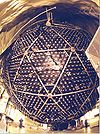- CHOOZ
-
CHOOZ was a long baseline neutrino oscillation experiment in Chooz, France. Its major result was setting limits on the neutrino oscillation parameters responsible for changing electron neutrinos into other neutrinos. Specifically, it found that sin2(2θ13) < 0.17 for large δm2 and δm2 > 8×10−4 eV2 for maximal mixing.[1] It will be superseded by the Double Chooz experiment, which uses the same lab space.
Contents
Neutrino source
CHOOZ used neutrinos from two pressurized water reactors, which provide a >99.999% ν
e source. The average neutrino energy was approximately 3 MeV, and the detector was roughly 1000 m from the reactor. The intensity was measured using both the heat balance and neutron output of the reactor, and was known to better than 2%. Detailed modeling of the reactor cores was used to predict both the intensity and energy spectrum of the neutrinos as a function of time. Neutrinos were observed via the inverse beta decay reaction (p + ν
e → n + e+
).[1]Detector
The CHOOZ detector was underground, with a 300 meter-water-equivalent overburden to reduce cosmic ray backgrounds. The detector itself was 5.5 m in diameter and 5.5 m tall. The detector was composed of three regions. The innermost region (region I) contained 5 tons of scintillator doped with gadolinium in a Plexiglas container. The gadolinium quickly captured the neutrinos produced in the inverse beta decay. The second region (region II) contained 17 tons of undoped scintillator to capture the electromagnetic energy from the inverse beta decay (~99%) and the photons from the neutron capture in the Gd (>95%). The outer surface of region II contained 192 inward facing photomultiplier tubes (PMT) held in an opaque plastic structure.
The outermost region (region III) contained ninety tons of the same undoped scintillator as region II and vetoed cosmic ray events using 48 PMTs.
The Plexiglas layer between regions I and II was clear, to allow scintillation light from region I to be observed by the PMTs in region II. The inner surface of the region II container was painted black to avoid reflections, which would degrade position measurements. The outer surface of the region II container and the inner surface of the region III container were painted white to maximize the veto signals.
Data sample
CHOOZ collected data for a total of 8210 hours: 3420 hours with neither reactor running, 3250 hours with one reactor running, and 1540 hours with both reactors running. A total of 2991 neutrino candidates were observed during this period, with 287 of the candidates occurring during the reactor off periods. The correlated background was 1.01 events per day, and the uncorrelated background was 0.42 events per day. The neutrino yield was also studied as a function of reactor power, fuel burnup, and for each reactor separately.
The energy spectrum of the positrons and the calculated direction of the incoming neutrino were also calculated. All distributions agreed with predictions.
Neutrino oscillation searches
Three analysis techniques were used to search for neutrino oscillations. The most powerful method used a global χ2 fit of seven positron energy bins for each reactor, for a total of fourteen bins. The χ2 was calculated for various (θ, δ m2) combinations. The full 14 × 14 covariance matrix was used to account for correlations among the bins. The χ2 statistic also includes a term for the overall neutrino normalization (with an uncertainty of 2.7%) and a term for the energy calibration (with an uncertainty of 1.1%). The global minimum, with a χ2 probability of 96%, corresponds to sin2(2θ) = 0.23, δm2 = 8.1×10−4 eV2, overall neutrino normalization = 1.012, and energy scale = 1.006. The no-oscillation hypothesis is also has a high χ2 probability of 93%, corresponding to an overall neutrino normalization = 1.008 and energy scale = 1.011.
Interpretation of results
The CHOOZ results place limits on the PMNS matrix element Ue32. Two possibilities exist, Ue32 < 0.03 or Ue32 > 0.97. The solar neutrino problem excludes the second inequality, therefore Ue32 is restricted to small values. The CHOOZ data also indicate a strong preference for the ν
μ → ν
τ maximum mixing hypothesis.Note on naming
The CHOOZ collaboration is not consistent in its capitalization. The experiment sometimes appears as Chooz and sometimes as CHOOZ. However, it is not an acronym.
References
- ^ a b M. Apollonio et al. (CHOOZ Collaboration) (2003). "Search for neutrino oscillations on a long base-line at the CHOOZ nuclear power station". European Physical Journal C 27: 331–374. arXiv:hep-ex/0301017. Bibcode 2003EPJC...27..331A. doi:10.1140/epjc/s2002-01127-9.
External links
Neutrino detectors, experiments, and facilities Discoveries 
Operating Construction Retired Proposed Cancelled See also Categories:- Reactor neutrino experiments
Wikimedia Foundation. 2010.
